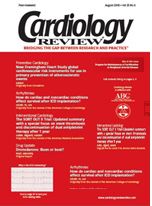Part 3: Overview of study designs
In the previous installments of this series on clinical research, I introduced the different study designs and included a brief description of each. In this installment, I build on the major clinical research designs and address the strengths and weaknesses of each.
Ecologic studies use available population data to determine associations among diseases, rates, and exposures in the population. Their main use is for hypothesis generation because they cannot address causality to any important degree. The ability to access existent, readily available data means that the study should be relatively inexpensive, quick, and simple. Thus, if an association has not been explored in the literature, this design might be appropriate as an early study to support future efforts. The weaknesses beyond the study’s inability to address causation, however, are numerous and include: (1) the fact that population information may not readily apply to individuals, (2) there is almost no ability to control for other variables that might influence the association, (3) there is little or no control of data quality, and (4) the concept of the ecologic fallacy is always present. What is the ecologic fallacy? It relates to the aforementioned issue that observations in the aggregate do not necessarily hold true for an individual. For example, one might want to assess the association between cigarette smoking and suicide. Indeed, one may find that the sale of cigarettes is highest in those states with the highest suicide rates. However, it may not be true that the suicides are occurring in the cigarette smokers.
The study design of case reports and case series is obvious, and their main weakness is, again, the inability to address causality. They should not be discounted and deemed unimportant, however. It was a case series of echocardiographic findings in patients who had taken fen-phen that set into motion the whole debate regarding the association of valvular abnormalities with combination appetite suppressant therapy.
In cross-sectional studies, one defines and describes disease status (or outcome), exposures, and other characteristics at a point in time to evaluate associations among them. The operative phrase for cross-sectional studies is at a point in time. Cross-sectional studies contrast with cohort studies in that cohort studies observe the association between exposure and outcome (for example, from health to disease or from disease to an event). This, in turn, contrasts with a case-control study, wherein the investigator identifies a certain outcome in the population, matches that “diseased group” to a “healthy group,” and identifies differences in exposures between the two groups. Cohort studies similarly attempt to find an association between an exposure and ultimate outcome. One example of how cohort studies differ from case-control studies is that with case-control studies, outcome is identified and exposure is sought, whereas in cohort studies, exposure is identified and outcome is sought (Figures 1—3).
Figure 1 is a diagram of a typical cross-sectional study. In a target population, the exposure and outcomes are determined, and the four possibilities are analyzed. In this example, the exposures to electromagnetic energy and cancer at a point in time are examined for a relationship. In Figures 2 and 3, the diagram shows that persons exposed to electromagnetic energy and those who were not are followed for a period of time, and cancer rates are determined in the two groups (or cancer cases and exposure are retrospectively analyzed).
In the randomized-controlled trial (RCT), the exposure is controlled by the investigator, which contrasts it with all the other study designs (Figure 4).
As previously mentioned, the differences among the various study designs will be discussed in more detail later. For now, however, one should be able to begin to understand the key differences and therefore the limitations of each study design and the circumstances in which one design might be preferable over another.
If we use the example of exposure to electromagnetic energy and cancer (eg, leukemia) in a cross-sectional study, a population is identified (target population), cancer rates are determined, and exposure and lack of exposure to electromagnetic energy are ascertained. One then analyzes the exposure rates in the cancer-free and cancer-present subjects and whether the cancer rate is higher in those who were exposed; a hypothesis regarding the association is then generated. This would be a relatively inexpensive way to begin to look at the possible association among these variables, but limitations should be obvious. Because there is no time determination in cross-sectional studies and because exposure to electromagnetic energy, if it did cause cancer, would likely have to occur over a period of time, one could easily miss an association.
With cohort studies, the time issue is addressed because subjects who are exposed are followed and the development of disease (outcomes) is ascertained in the exposed versus the unexposed. A cohort study is close to an experimental design (RCT), except that the exposure occurs in nature and is therefore not controllable by the investigator. One of the other major limitations of this design is that the assumption is made that the subject under study is free of the outcome in question at the study’s onset. Clearly, this assumption may be inaccurate, particularly for diseases that have longer incubation periods and asymptomatic states (eg, coronary artery disease).
In the next installments, I will delve deeper into RCTs and begin to address the very important issue of causation.
